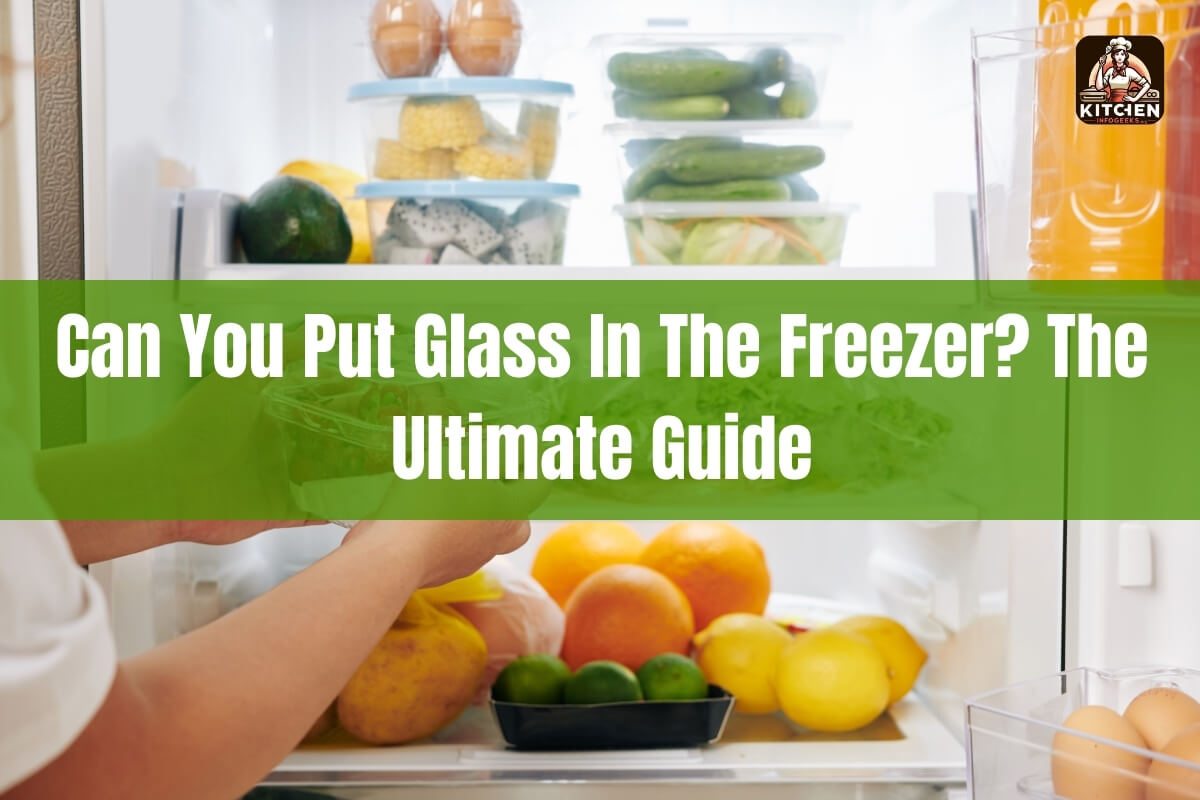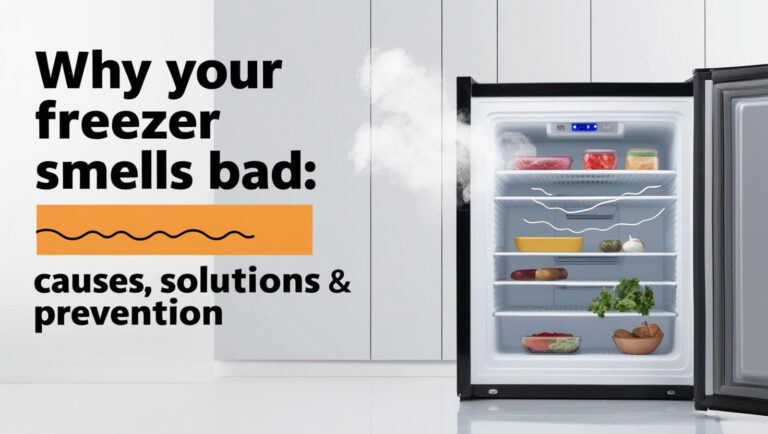
We’ve all been there – you want to chill a drink or store some leftovers, but you’re unsure if your glass container is freezer-safe. The short answer is yes, you can put glass in the freezer, but with some important caveats. In this detailed guide, we’ll cover everything you need to know about freezing glass, from the types of glass that are safe to use to tips for avoiding cracks and breaks.
Here’s what we’ll dive into:
- The science behind why glass can crack in the freezer
- How to identify freezer-safe glass containers
- Steps to properly prepare glass for freezing
- Techniques for thawing frozen glass containers safely
- Unique uses for freezing glass beyond food storage
- FAQs and troubleshooting common issues
So, let’s get started!
Understanding Why Glass Cracks in the Freezer
Before we discuss how to safely freeze glass, it’s important to understand the science behind why glass can crack or shatter when exposed to extreme temperature changes.
The Thermal Shock Principle
The cracking or shattering of glass in the freezer is caused by a phenomenon called thermal shock. This occurs when the temperature of the glass changes too rapidly, causing uneven expansion or contraction of the material.
When you place a room-temperature glass container in the freezer, the outside surface cools and contracts much faster than the inside. This creates stress within the glass, eventually leading to cracks or shattering if the stress becomes too great.
Factors That Increase Thermal Shock Risk
Several factors can increase the risk of thermal shock and cracking when freezing glass:
- Temperature Difference: The greater the temperature difference between the glass and the freezer environment, the higher the risk of thermal shock.
- Glass Thickness: Thicker glass is more prone to thermal shock because the interior takes longer to cool or heat up compared to the outer surface.
- Glass Type: Some types of glass, like tempered or borosilicate, are designed to better withstand thermal shock. Regular soda-lime glass is more vulnerable.
- Existing Imperfections: Any existing chips, cracks, or scratches in the glass can act as stress points, increasing the likelihood of cracking during temperature changes.
Understanding these principles is crucial for safely freezing glass containers. In the next section, we’ll discuss how to identify freezer-safe glass.
How to Tell if Your Glass is Freezer-Safe
Not all glass is created equal when it comes to freezing. Some types are better equipped to handle the stresses of extreme temperature changes, while others are more likely to crack or shatter.
Tempered Glass
Tempered glass is one of the best options for freezing. This type of glass undergoes a special heat-treatment process that increases its strength and makes it more resistant to thermal shock.
You’ll often find tempered glass used in:
- Canning jars (e.g., Ball, Kerr)
- Oven-safe glass bakeware
- Some reusable food storage containers
Look for the words “tempered” or “thermal shock resistant” on the packaging or product description.
Borosilicate Glass
Another freezer-friendly option is borosilicate glass, which is highly heat-resistant due to its unique chemical composition. This type of glass is often used in laboratory equipment and some high-end cookware and bakeware lines.
Popular borosilicate glass brands include:
- Pyrex (Note: Only Pyrex products made before 1998 are true borosilicate)
- Anchor Hocking
- Boroscilicate
Regular Soda-Lime Glass: Use With Caution
Most regular, inexpensive glasses, bottles, and jars are made from soda-lime glass. This type of glass is not designed to withstand extreme temperature changes and is more likely to crack or shatter in the freezer.
If you plan to freeze soda-lime glass containers, take extra precautions and be prepared for a higher risk of breakage. It’s generally best to avoid freezing them if possible.
The key takeaway is to look for products specifically labeled as “freezer-safe,” “thermal shock resistant,” or made from tempered or borosilicate glass. Taking this simple step can greatly reduce the chances of your glass cracking in the freezer.
Preparing Glass for the Freezer: Step-by-Step
Even with freezer-safe glass, it’s important to take the proper precautions when freezing to minimize the risk of cracking or shattering. Here’s a step-by-step guide to prepping your glass containers for the freezer:
- Cool Food Completely: Never place piping hot food or liquids directly into a glass container and then into the freezer. This extreme temperature change greatly increases the risk of thermal shock. Always allow hot items to cool completely to room temperature before transferring to a glass container and refrigerating until fully chilled.
- Choose the Right Container: Use wide-mouth, straight-sided containers rather than narrow shapes. The wider opening allows liquids and foods to expand more easily as they freeze.
- Leave Headspace: Whether freezing liquids or solids, be sure to leave enough headspace at the top of the container (about 1 inch) to allow for expansion as the contents freeze.
- Avoid Overfilling: Similarly, don’t overfill containers, as the contents will expand and could crack the glass. A good rule of thumb is to fill no more than 3/4 full.
- Cool Gradually: Once filled and sealed, place the glass containers in the refrigerator and allow them to gradually cool before transferring to the freezer. This slow cooling process reduces thermal shock.
- Freeze Quickly: Once fully chilled in the refrigerator, transfer the glass containers to the freezer promptly. The faster they freeze, the less chance of cracking from uneven cooling.
By following these simple steps, you can greatly minimize the risks associated with freezing glass and help ensure your containers emerge from the freezer intact.
Safely Thawing and Reheating Frozen Glass Containers
Just as the freezing process requires care, so does thawing and reheating frozen glass containers to prevent cracks and breaks. Here are some tips:
Thawing Tips
- Refrigerator Thawing: The safest way to thaw a frozen glass container is to transfer it from the freezer to the refrigerator and allow it to slowly defrost. This gradual process prevents shocking the glass.
- Cold Water Bath: If you need to speed up thawing, place the frozen glass container in a bowl or sink of cold water, replacing the water as needed as it warms up.
- Never Microwave or Oven Thaw: Avoid using the microwave or oven to thaw frozen glass, as the uneven heating can easily cause cracking.
Reheating Tips
- Bring to Room Temp First: Before reheating a thawed glass container in the oven or microwave, always allow it to come to room temperature first to prevent shocking the glass.
- Lower Oven Temp: If oven reheating, use a lower temperature (300°F or below) and increase cooking time to gently heat the glass.
- Microwave in Intervals: For microwave reheating, use lower power settings and heat in short intervals, stopping and stirring frequently.
- Avoid Direct Heat Sources: Never place a cold glass container directly on a hot burner or grill, as the direct intense heat can easily crack or shatter the glass.
By taking your time during the thawing and reheating processes, you can enjoy your frozen foods while keeping your glassware intact.
Creative Uses for Freezing Glass
While most people think of freezing glass for food storage purposes, there are actually many creative ways to utilize frozen glass containers around the home:
Unique Drink Chillers and Beverage Holders
- Freeze wide-mouth glass jars or containers to create whimsical drink chillers. As the ice melts, it creates a fun condensation effect on the outside of the glass.
- Pre-freeze small glass bottles, jars, or shot glasses to use as instant beverage coolers. Simply nestle your drink inside to keep it frosty cold.
Decor and Party Ideas
- Fill decorative glass containers or vases with water tinted with food coloring, freeze, and use as festive table centerpieces.
- Create glowing ice luminaries by freezing glass jars or pitchers filled with water and a submersible LED light.
- Make whimsical ice candle holders by filling glass containers with water and a wick. Once frozen, place a votive or tealight candle on top.
Skincare and Beauty Hacks
- Freeze small shot glasses or jars filled with your favorite skincare products like moisturizers, serums or face masks. The frozen glass will chill and depuff the skin when rolled over the face.
- Make a DIY facial cooling massage tool by filling a small clean jar or bottle with water and freezing it. Gently roll the frozen glass over your face to reduce puffiness and redness.
- Chill cosmetic products like makeup, nail polish or lip gloss by storing them in the freezer in their glass containers. The cooler temperature can help products last longer.
- Create a refreshing cold therapy treatment by freezing a glass bottle or jar filled with water or skin-safe oil. Roll it over sore muscles for relief.
No matter how you choose to use frozen glass containers, always handle them with care and allow for proper thawing to prevent cracks. With a little creativity, freezing glass can lead to all sorts of fun and functional uses!
FAQs on Freezing Glass
Despite covering all the key aspects, you may still have some lingering questions about putting glass in the freezer safely. Let’s address some frequently asked queries:
Q: Can you freeze glass bottles like beer or soda bottles?
A: It’s generally not recommended to freeze glass bottles, especially those made of standard soda-lime glass. These tend to be thinner and under more pressure from carbonation, increasing the risk of cracking or explosion. Stick to freezer-safe, thicker-walled containers.
Q: Is it safe to freeze mason jars with metal lids?
A: Yes, mason jars with metal lids can be frozen safely when following proper techniques. Just be sure to leave enough headspace, cool contents before freezing, and use straight-sided jars rather than shoulder/neck varieties that can crack under pressure.
Q: Can glass Tupperware go in the freezer?
A: Glass Tupperware and similar reusable storage containers are usually freezer-safe, but always check the product specifications. Look for “freezer-safe” labeling and choose tempered varieties when possible. Follow guidelines for headspace and gradual cooling.
Q: Why did my glass container crack even though it was freezer-safe?
A: Even freezer-rated containers can crack due to existing cracks/chips, overfilling, rapid cooling, or failing to leave proper headspace. Always inspect containers and follow best freezing practices. Some cracking is unavoidable with extreme temperature changes.
Q: How long can I leave glass containers in the freezer?
A: As long as the containers remain sealed with no air exposure, most foods will keep indefinitely in a properly frozen glass container. However, quality and taste may diminish over extended periods due to freezer burn. Use frozen foods within 2-6 months for best quality.
Remember, a little preparation can go a long way in preventing cracked or shattered glass when freezing containers. Follow safety guidelines, choose the right containers, and you’ll be freezing like a pro!
Conclusion
Putting glass in the freezer doesn’t have to be a daunting task. By understanding the risks of thermal shock, identifying freezer-safe glass, and following proper cooling and thawing techniques, you can safely store foods or get creative with unique frozen glass projects.
The key takeaways are:
- Use tempered or borosilicate glass designed to withstand temperature extremes
- Always cool hot items before freezing and leave ample headspace
- Freeze and thaw glass containers gradually to avoid shocking the material
- Get creative with frozen glass for beverage chillers, decor, and even beauty treatments!
With this comprehensive guide, you now have all the knowledge needed to confidently put glass in the freezer without worry of cracks or shatters. So go ahead, pop those containers in the freezer and enjoy perfectly chilled foods and drinks!






